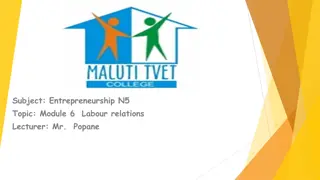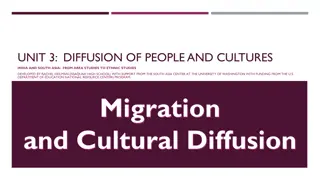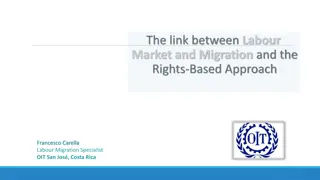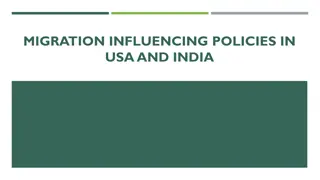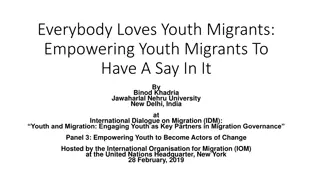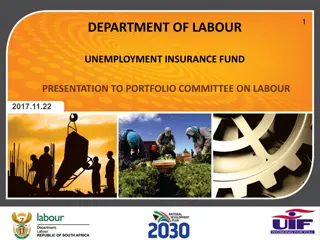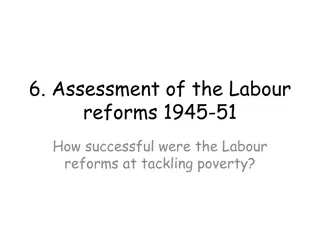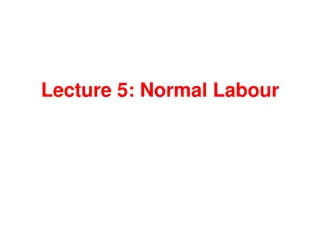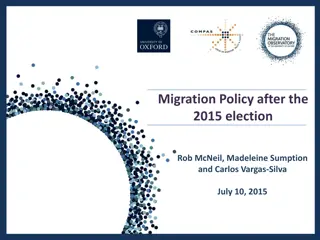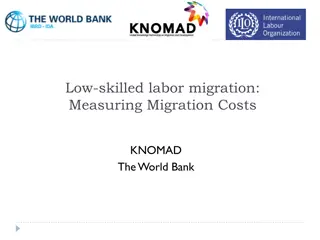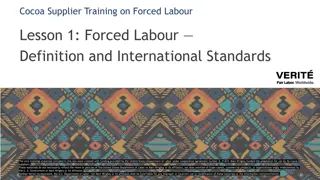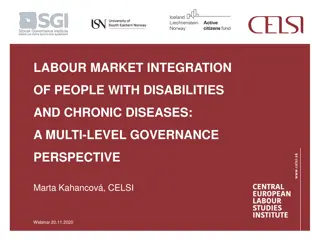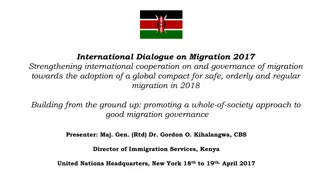Labour Migration Governance in Africa: Initiatives and Challenges
This initiative focuses on the governance of labour migration in Africa, exploring the figures, features, opportunities, and challenges associated with both intra- and inter-regional migration. It delves into the drivers behind migration such as demographic pressures and global skills shortages, as well as the various opportunities it presents for host countries, countries of origin, and migrants themselves. The aim is to develop comprehensive policy responses to address the complexities of labour migration in the African context.
Download Presentation

Please find below an Image/Link to download the presentation.
The content on the website is provided AS IS for your information and personal use only. It may not be sold, licensed, or shared on other websites without obtaining consent from the author.If you encounter any issues during the download, it is possible that the publisher has removed the file from their server.
You are allowed to download the files provided on this website for personal or commercial use, subject to the condition that they are used lawfully. All files are the property of their respective owners.
The content on the website is provided AS IS for your information and personal use only. It may not be sold, licensed, or shared on other websites without obtaining consent from the author.
E N D
Presentation Transcript
. A joint new BOLD initiative Labour Migration Governance for Development and Integration in Africa AU-ILO-IOM-ECA In collaboration with RECs
CONTENT Background/Context Figures and Features of Labour Migration in Africa Opportunities and Challenges Continental Policy Responses AU led Comprehensive Programmatic Response Joint Initiative Areas of Focus Journey to deliver ...
Figures and Features of Labour Migration in Africa African migration is inter (51) and intra- regional: 49% Sub Saharan Africa higher at 65% (2011) 71 - 80% in West Africa, 66% in Southern Africa, 52% in East Africa - 23% in Central Africa - 6% in North Africa.
Drivers... Demographic pressures --ageing and increasing deficits in labour forces -- Africa confronts a growing, educated youthful population Jobless growth and a dearth of decent work opportunities Growing inequalities between and within countries (rising exclusion) Fragility of States breakdown of effective governance Globalized access to information Global skills shortage which is set to worsen 2006 4.3 million shortage of health workers (WHO) and will reach 12.9 million in 2035 MGI study calculated that by 2020, global shortages of high skilled professionals will reach 38 million to 40 million fewer workers with tertiary education (college or postgraduate degrees) than employers will need
Opportunities ... Increasing recognition/documentation of the developmental benefits ... Host Countries: Renders traditional sectors like agriculture and domestic services viable Develops and sustains sectors like mining, petroleum, health, education, commerce, etc Meet specific skills gaps in managerial, technical, ICT, industrial Fosters enterprise growth Countries of Origin: Transfer of skills acquired by return migrants Remittances Social remittances education, gender equality, Financial inflows (US$ billions) 2013 - top 10 Nigeria (21) and Egypt (17)* Context FDI - 57 (USD billion) ODA 46 (USD Billion)
Opportunities For the Migrant Decent Work Self Actualisation Professional Fulfilment Etc ...
Challenges ... Inadequate reliable, accurate and comprehensive data on labour migration. Existing data is primarily movement data, at best providing some indication of stocks and flows, while there is little or no data on migrants skills and employment profiles, labour market participation, conditions of work, or social protection coverage. Inadequacies concerning the recognition of qualifications and competencies across borders
Absence of/lethargic implementation of free movement protocol rights and mechanisms developed by RECs Limited political will, capacity gaps and poor institutional coordination are central concerns at national level Weakness of pertinent labour market institutions Lack of comprehensive national labour migration strategic and policy frameworks -Some countries are moving in this direction
Challenges ... Ineffective talent management strategies hence emigration of skilled Africans contributing to total loss of talent Lack of or inadequate protection for migrant workers and their families from exploitation and hostility Limited or non-access to and portability of social security benefits Security agenda often limits the broader understanding of labour migration as a fundamental issue for development, regional integration and the labour market
Continental Policy Instruments on Labour Migration ... 2006 AU Migration Policy Framework: Calls for a rights-based approach to labour migration based on ILO Conventions No 97 and 143 as well as International Convention on the Rights of All Migrant Workers and Members of their Families 2013 AU LSAC: RECs should consider the issue of regional labour migration as an important factor in sustainable development.
Joint Programme Support ... Labour Migration Governance Objective: Strengthen the effective governance and regulation of labour migration and mobility in Africa, under the rule of law with the involvement of key stakeholders: all relevant ministries (MOL, MFA, MOI) Employers, Private Sector,Trade Unions Migrants/Diaspora
Joint Programme Support ... Labour Migration Governance Initial four year ten-year vision will contribute to obtaining the development potential of labour and skills mobility in Africa by supporting effective governance of labour migration and protection of migrants Implement the AU Migration Policy Framework and AUC Strategic Plan 2014-2017 Aligned with Ouagadougou + 10 plan of action on Labour Migration programme within a
Joint Programme Support ... Labour Migration Governance Strengthen effective governance of labour migration in Africa: Increase domestication of key international standards on labour migration Achieve wider elaboration, adoption and implementation of harmonized free circulation regimes and coherent national labour migration policy in the RECs Enable labour institutions and social partners in RECs and national governments to facilitate labour migration governance, policy and administrative responsibilities Establish regional mechanisms for tripartite policy consultation and coordination on labour migration issues, and consultation and technical cooperation with other regions
Joint Programme Support ... Labour Migration Governance Support implementation of labour migration standards and policy: Enhance collection of gender and age disaggregated data on migrants economic activity, employment, skills, education, working conditions, and social protection situations. Initiate/support efforts to resolve skills shortages and skill education mismatches while increasing recognition of harmonized qualifications across Africa Obtain Decent Work for migrants with effective application of labour standards to migrant workers Extend Social Security to migrants through access and portability regimes compatible with international standards and good practice
Areas of actions Collection of gender and age disaggregated data on migrants economic activity, employment, skills, education, working conditions, social protection Wider implementation of labour migration regimes Resolution of skills shortages and increased recognition of harmonized qualifications across Africa Strengthened capacity of labour institutions in AUC, RECs and national governments on labour migration Regional tripartite policy coordination; & Cooperation with other regions Extend Social Security to migrants through access and portability regimes
Indicators to be collected MODULE A: International Migrant Stocks 1. Resident population by sex and by labour force participation total & youth (total & migrants) 2. Working age population by sex & by level of qualification (total & migrants) (ISCED 2011) 3. Migrants by country of origin 4. Employed migrants by country of origin 5. Employed persons by industry (total & migrants) (ISIC, Rev.4) 6. Employed persons by occupation (total & migrants) (ISCO-08) 7. Employed persons by sex and by status in employment (total & migrants) (ICSE-93) 8. Employed persons by sex and by average monthly wages (total & migrants) MODULE B: International Migrant Flows 9. Inflows of migrants by sex and by country of origin 10. Inflows of migrants by sex and by level of qualification 11. Inflows of employed migrants by industry (ISIC, Rev.4) 12. Inflows of employed migrants by occupation (ISCO-08) MODULE C: Emigration 13. Nationals abroad by sex and by country of residence 14. Outflow of nationals by sex and by country of destination 24
l'Union Africaine et les communautes economiques regionales ont convenu d'organiser un atelier de formation et de validation des donnees de la migration de la main-d'oeuvre du 28 au 30 septembre en Ethiopie.






